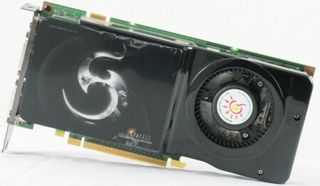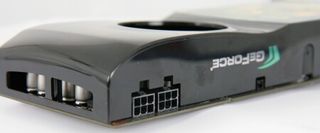Nvidia GeForce 9800 GTX Review
The Point Of View 9800 GTX
As for the GeForce 9800 GX2, Point Of View was again the quickest manufacturer to offer a test sample of its 9800 GTX. But like all the other models, this one is in conformity with the reference design, which is par for the course with high-end cards (although - unlike the 9800 GX2, which had too limited a potential sales volume to amortize the additional costs - there probably will eventually be more customized models of this one).

GeForce 9800 GTX

GeForce 8800 GTS
You have to admit that as far as visual design goes, Nvidia hasn't really tried to discourage comparison between the 9800 GTX and the 8800 GTS 512 MB. The double-slot design that channels air over the cooler and vents it outside the case (which the 9800 GX2 does not offer); a 4.08 W radial cooling fan with the axis tilted slightly to blow air closer to the base of the cooler; two dual-link DVI-I outputs and a TV connector. If you want to spot the differences, they include a second SLI connector (needed for Triple SLI support), a second PCI Express six-pin power connector (and not eight-pin as on the 9800 GX2), indicating higher power consumption; and finally the larger size. Unfortunately the card measures 26.7 cm, like the 8800 GTX, Ultra, 9800 GX2 and 3870 X2, and not 23 cm like the 8800 GTS 512 MB. It'll also have a tough time fitting into certain cases.

The card ships with a DVI-to-VGA adaptor, but also with a DVI-to-HDMI, with support for the active adaptor via a small HDMI input connector. There's also a 2 Molex -> PCI Express six-pin adaptor, which is useful for those who have only one such connector, whereas two are needed. No games are shipped with the card.
Test Configuration
After our 9800 GX2 review this is a test of the first midrange/high-end card to use Windows Vista, with SP1. In comparison to the GX2, we have lowered the resolutions to keep them in line with the performance of the cards we test here. On the other hand, all settings remain at maximum and we use Fraps and our standardized gameplay sequences for our tests.

Hardware
Stay on the Cutting Edge
Join the experts who read Tom's Hardware for the inside track on enthusiast PC tech news — and have for over 25 years. We'll send breaking news and in-depth reviews of CPUs, GPUs, AI, maker hardware and more straight to your inbox.
- Asus P5E3 Deluxe (Intel X38)
- Intel Core 2 Quad QX6850 (3 GHz)
- Crucial 2 x 1 GB DDR3 1333 MHz 7-7-7-20
- Western Digital WD5000AAKS
- Asus 12x DVD drive
- Coolermaster RealPower Pro 850W
Software
- Windows Vista SP1
- ForceWare 174.53 beta (9800 GTX)
- ForceWare 169.44 beta (GeForce 8 series)
- Catalyst 8.3 WHQL
Current page: The Point Of View 9800 GTX
Prev Page GeForce 9800 GTX: New Wine In Old Bottles Next Page Flight Simulator X-
BPT747 Interesting results, I have found several card makers (Palit, Asus, Evga, and Zotac) that make a 1GB 8800GT(S). Since you were speaking of the memory limitations of the 9800GTX, I am curious how these cards would preform with the 8800 driver optimizations you mentioned.Reply -
Spectere I purchased a GF9800GTX not long after it came out and the only time I recall hearing the fan spin up to high (which is fairly loud) is when the card first initialized itself when I turn my system on. I've logged many hours of game time on this rig and haven't heard it spin up at all. I'm using the ForceWare 174.74 drivers and an XFX branded card (if that would make any difference at all...probably not).Reply -
teamjawbox Would an Intel Core 2 Duo Dual Core E6600 (2.4ghz) 1066FSB processor bottleneck the 9800GTX? Trying to decide whether to get one or not and dont want to get it and not see an increase in performance due to my processor. Thanks!Reply -
TiberiumSoldier i am going to buy an intel Core 2 Duo E8500 with ASUS or XFX or eVGA 9800gtx and 2gb Corsair Dominator ram.. is this a good option??? or i should buy an AMD Phenom 9600?Reply
Most Popular

